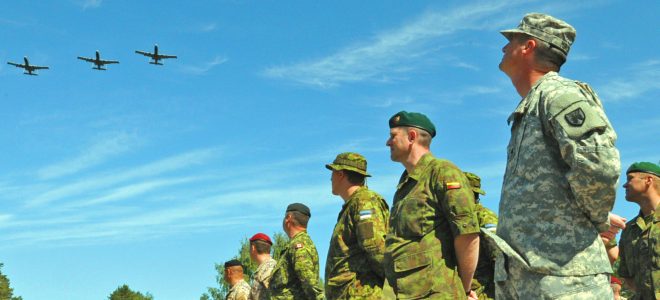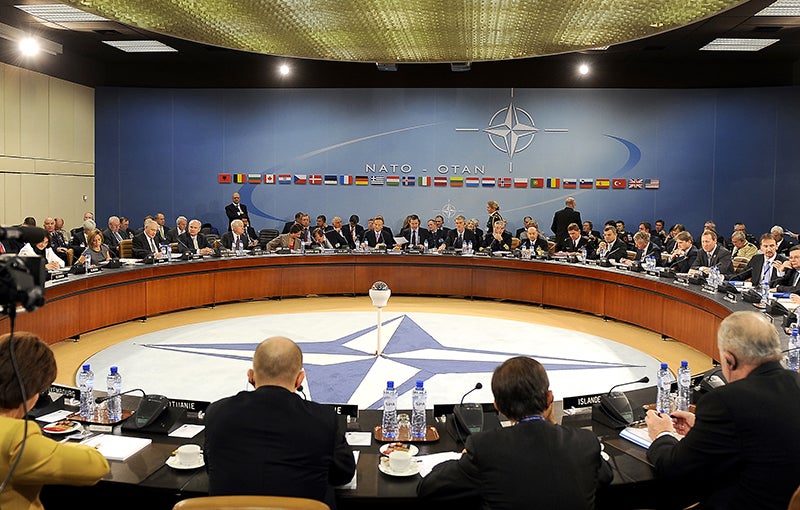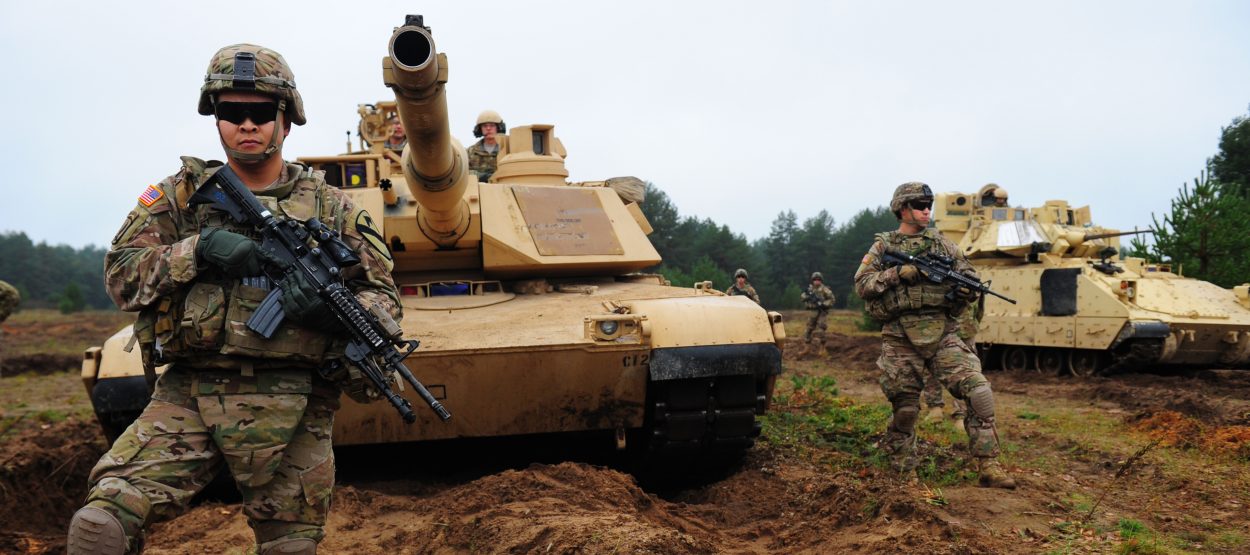

Michael Allen is an Associate Professor of Political Science and the Graduate Program Coordinator for the Master’s Program in Political Science at Boise State University. He has been at Boise State since 2012. His research includes work on asymmetric wars, interstate conflict, and the cost and benefits of US troop deployments globally. He teaches courses on international relations, foreign policy, civil war and terrorism, and quantitative methodology.
While the casting of ballots for the 2016 election is over and a clear victor will assume the office of the presidency in January 2017, the ideas and issues of defeated candidates have not simply disappeared. They will continue to percolate, evolve and, for some, return as further political debates in the House and Senate, perhaps continuing to our next election cycle. While some arguments between the two contenders were chalked up to “just words,” words, especially in the realm of foreign policy and international relations, matter.
Republican president-elect Donald Trump’s focus on foreign policy during the election cycle included several ideas (often short and intended to be developed after the campaign) about how to deal with a range of countries from traditional allies to traditional rivals; however, those soundbites picked up on important issues that have held long purchase in United States politics. Trump articulated a few misgivings about the North Atlantic Treaty Organization (NATO) and the failure of some members to live up to their share of defense spending. And Trump is not alone; Obama has attempted to shore up members’ contributions to NATO and recently agreed to concentrate more NATO forces and U.S. troops to Eastern European members of the alliance. The question of whether U.S. allies properly contribute their fair share to the alliances they share with the United States, or if they free ride on those agreements and force the U.S. to overpay for their protection, is an old question.
Along with co-authors Julie VanDusky-Allen at Boise State and Michael Flynn at Kansas State, I have investigated this question in terms of troop deployments abroad. Beginning with the end of the 19th century, and dramatically accelerating after the end of World War II, the U.S. has stationed thousands of service members across the globe. This move was part of a complex set of security agreements intended to exercise both U.S. influence in the region and shore up the defense of allied (or friendly) nations. Troop deployments are uniquely fluid in that the U.S. can choose to shift the number of troops in each country at any time. This is in contrast to alliance agreements and military bases, both of which are longer lasting, stable commitments. In our research, we examined how United States troop commitments globally can affect the year-to-year defense burdens of a country (how much a country spends on defense relative to its GDP) and found some interesting divergences between non-allies, allies, and NATO allies (article 1, article 2).
Between our research and the existing international relations data, we find a few answers to the twin questions of “Do U.S. allies contribute fully to alliances?” and “If not, why?” To explore this issue, I offer three ways to think about the problem: Collective Action Problems, Asymmetric Alliances, and Joint Production.
THE COLLECTIVE ACTION PROBLEM OF COLLECTIVE SECURITY

Former U.S. Defense Secretary Robert M. Gates and other NATO Ministers of Defense and of Foreign Affairs in Brussels, Belgium, 2010. DOD photo by Master Sgt. Jerry Morrison.
One of the earliest and strongest responses to the NATO dilemma and the issue of equal contributions by members has come from Collective Action research. Mancur Olson, an economist who, had he lived longer, would likely have been a contender for a Nobel Prize for his work on collective action, formulated and provided answers to a problem we see in every social science: Why groups that could choose to do something to make everyone in their group better off choose not to. Olson argued that a collective action problem arises when a group of individuals (or other actors, like countries) could clearly benefit from an action, but it comes at a cost. If the object provided is something that is a “public good,” an item that everyone can enjoy (“non-excludable”), and one member’s consumption of that good does not affect other people (“non-rivalrous”), then there is a rational reason not to help provide that good. To the point, if a single member shirks on paying for a good, but enough other people are willing to pay for it, that individual member will still be able to benefit without contributing to the group. If that member shirks, and not enough other people are willing to pay for it, then that member spends no resources and does not receive the benefit, just like everyone else. Classic examples of public goods include clean air, clean water, national defense, free trade rules, voting in a democracy, or lighting at night.
Collective defense is a kind of public good for members of an alliance. Each member in the alliance would be better off if they all agreed to defend one another if attacked, but it is expensive to provide that security both prior to an attack as well as when actually called to arms. As such, it is no surprise that Olson, and his co-author Richard Zeckhauser, applied the logic of collective action to NATO in the 1960s when debates were raging about the United States over-contributing to NATO.
Typically, there are three traditional solutions to the collective action problem. First, if the group contains few members, it is easier to observe, report, and shame members for defection. A small group tends to have a stronger incentive to work together and is better able to pressure those who would shirk from the collective good. As a group increases in size, it becomes easier for members to anonymously shirk and not contribute their fair share while still reaping the benefits of the public good. Second, if one or more actors offer selective benefits to individuals for their contributions, that can make up for some of the costs of participation. For example, if not enough people vote in a democracy, we may try to make the cost of voting cheaper (in Idaho we offer both early voting and mobile voting units to get out the vote) or offer incentives (stickers) to encourage people to still come out.
Third, and relevant here, a member of the group may have a stronger interest in the collective good and may overpay for its provision. Olson and Zeckhauser argue that NATO is a clear example of that. Some members, especially the United States, have a stronger incentive for NATO to exist and deter encroachments from the Soviet Union. Therefore, the U.S. contributes a larger share to ensure NATO’s existence, which effectively allows smaller members to free ride. The authors argue that simply agitating for the other countries to pay more will likely hurt U.S. interests and, if it is a long-term goal of the U.S. to have other members pay more, the U.S. should focus on altering institutional rules, not just publicly demanding fairness.
ASYMMETRIC ALLIANCES

A second look at this problem adds additional traction to the question of why the United States pays more than its allies for its own defense. A vein of research from the 1990s looks at the question from a different standpoint, arguing that looking at financial costs and security provision as our only two variables to evaluate an alliance skews our perception of why alliances form. A large percentage of alliances occur during peacetime when a state does not have a clear threat and, perhaps more notably, the United States forms alliances with countries that are substantially weaker and cannot contribute to its defense. At first glance, just like our NATO puzzle, it seems odd that the United States would pay for other countries’ security without gaining any security in return.
Morrow, among others, argues that a second dimension gives us a clear answer to this puzzle. When a weaker country joins the U.S. in alliance, the U.S. pays for the security costs while the weaker country sacrifices some autonomy over its foreign policy to the United States. During the Cold War and the War on Terror, the United States allied with much weaker countries as it gained leverage on its global objectives. These objectives would have been more difficult to obtain without the help of those weaker states. Some research suggests that we can envision the world as a series of contractual hierarchies that range from equal partners to states that have ceded significant sovereignty over their foreign policy agendas to the United States. In two different works with my co-authors, we find that this seems to be the case for the relationships between the United States and the states to which it commits troops. As the U.S. increases security commitments to another country, that country spends less on its own defense as it functionally outsources some of its security to us.
JOINT ECONOMIES OF PRODUCTION

Beyond the security commitments between powerful and weak states along a security-autonomy trade-off continuum is a unique finding about the NATO alliance. While we suspect that many countries use an alliance to shift spending priorities from defense to public expenditures (a similar finding that Matt DiGiuseppe and I find when we investigate the role credit ratings and borrowing for public expenditures has on alliance formation), we argue that this is less likely when an allied pair have similar prospects for providing significant contributions to collective defense. Additionally, beyond being able to contribute equally to defense, many European NATO members are on the frontline of a conflict with the Soviet Union. As such, their interest in providing adequate security for themselves should be higher than U.S. alliances with states that have a less grave and imminent threat.
We find in our research that there is a divergence in how states respond to new deployments. While non-allied states are more likely to freeride on U.S. deployments to their territory (more accurately, trade autonomy over their foreign policy decision-making in exchange for U.S.-provided security) NATO allies do the opposite. When the U.S. increases the number of troops to a NATO country, the country responds by increasing its own defense expenditures. This finding is important for two reasons. First, it shows that where we deploy troops seems to matter in regard to our objective. Second, while members’ contributions to NATO are less than what politicians in the U.S. may desire, we do see a matched increase of NATO members’ defense expenditures. This is important to the alliance as NATO membership and collective security suggest that an attack on one state requires the response of each member of NATO. As such, it will not just be NATO acting in collective defense; it will be the national armies of the countries from NATO. As such, increases in military expenditures in another NATO country due to U.S. deployments are potential security returns to the United States in the future.
Related to this, we also explored the contextual meaning of troop deployments within regions that have various levels of U.S. troops. That is, we wanted to know how U.S. troop deployments to a country affect that country’s commitment to its own defense when surrounded by states that do or do not host U.S. troops as well. In this research, we see that the relationship between troop deployments and defense expenditures depend on those environments. A country is most likely to reduce defense expenditures if it also is surrounded by states that host U.S. troops. If it is surrounded by states that do not host U.S. troops, it does not change its defense expenditures based on more U.S. troops. However, NATO allies have a similar but opposite pattern. NATO allies increase their defense expenditures when surrounded by countries that host U.S. troops; however, NATO members surrounded by countries that do not host U.S. troops do not alter their behavior based on more U.S. troops. This may also indicate some level of competition to attract or maintain troops in NATO countries, giving the U.S. an important tool to raise defense spending levels.
Moving beyond direct expenditures, the United States gains a few other benefits from NATO that decrease the costs of United States foreign policy. Having bases and access to bases in Europe, as well maintaining military assets in forward-deployed positions, reduces the logistical costs of maintaining and supplying forces abroad in times of conflict (such as in Afghanistan). NATO also provides additional cost-savings and benefit-enhancers in standardizing military doctrine and military equipment across countries, factors that are not captured purely by NATO member contributions.
In sum, when judging a state’s contribution to NATO, direct contributions are only part of the story. A state may indirectly contribute to the collective defense of the alliance by raising its own defense burdens and providing a more robust national defense for itself. From our research, we see that an important predictor of defense spending by NATO members is the level of troop commitments by the U.S. to that country.